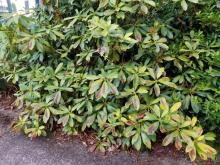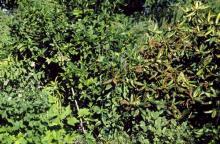See:
Cause A combination of sun exposure, air temperature above 90°F, and low available soil moisture in the root zone. Not all rhododendron cultivars take direct sun. The injury in itself is not serious, but it is unsightly and offers fungi and bacteria a place to enter and cause trouble. Frequently, saprophytic fungi develop in sunburned areas, which make it seem as if the basic problem is a fungus disease. Cultivars with heavy indumentum, a covering of fine hair on lower leaf surfaces, have less water loss during high heat periods and may not sunburn as much.
Symptoms Leaves of some cultivars often are injured in warm periods, and the center portion bleaches out to tan or off-white except near large veins. Damage is moist intense on the south or southwest side of plants. Exposure to sun just during the midday can also produce similar symptoms.
Cultural control Prevention is the key as there is no remedial action that can be taken once leaves are scorched by the sun, but effects are not fatal and new leaves will eventually cover damaged ones.
- Move the plant to a more shaded location.
- Provide some shade where it is now planted.
- Maintain watering during summer, especially during extreme heat events.
Reference Linderman, R.G. and Benson, D.M. 2014. Compendium of Rhododendron and Azalea Diseases and Pests, 2nd ed. St. Paul, MN:APS Press.



